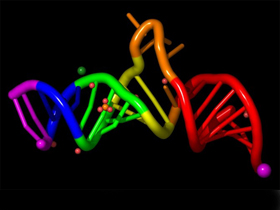Asked how the first cell came into being, evolutionists since the early 20th century have offered various theories. The Russian biologist Alexander Oparin proposed the first evolutionist thesis on this subject, suggesting that proteins formed first with a number of random chemical reactions on the primeval Earth, and that these then combined together to give rise to the cell. In the 1970s, it was realized that even Oparin's most basic assumptions, which he made in the 1930s were false: In the primitive world atmosphere scenario, he had included the gasses methane and ammonia that would permit the emergence of organic molecules. Yet it was realized that the atmosphere at the time was not rich in methane and ammonia, but contained high levels of oxygen that would break down organic molecules. (See The Primitive Earth.)
This dealt a serious blow to the theory of molecular evolution. It meant that all the "primitive atmosphere" experiments, carried by evolutionists such as Miller, Fox and Ponnamperuma, were invalid. For that reason, other evolutionist quests were launched in the 1980s, and the RNA World scenario was put forward. This suggested that rather than proteins, the RNA molecule containing protein information emerged first. According to this scenario-proposed in 1986 by the Harvard chemist Walter Gilbert-billions of years ago, an RNA molecule somehow capable of copying itself came into existence by chance. Later, under the influence of environmental conditions, this RNA molecule suddenly began producing proteins. Later, when the need was felt to hide their information in a second molecule, the DNA molecule somehow emerged.
Instead of accounting for the beginning of life, this scenario-every stage of which is distinctly impossible and which is difficult to even imagine-made the problem even worse. It raised a number of insoluble questions:
1. Not even one of the nucleotides that comprise RNA can be accounted for in terms of chance. Then how did nucleotides come together in the appropriate sequence to give rise to DNA?
As researchers continue to examine the RNA-World concept closely, more problems emerge. How did RNA initially arise? RNA and its components are difficult to synthesize in a laboratory under the best of conditions, much less under really plausible ones. 205
2. Even if we assume that RNA, consisting solely of a chain of nucleotides, did come into being by chance, how did it decide to copy itself? By what mechanism did it succeed in doing so? Where did it find the nucleotides it would use while copying itself?
The evolutionist biologists Gerald Joyce and Leslie Orgel state the hopelessness of the situation:
Our discussion has focused on a straw man: the myth of a small RNA molecule that arises de novo and can replicate efficiently and with high fidelity under plausible prebiotic conditions. Not only is such a notion unrealistic in light of our current understanding of prebiotic chemistry, but it should strain the credulity of even an optimist's view of RNA's catalytic potential. 206
3. Even assuming that an RNA capable of copying itself did appear in the primeval world, and infinite amounts of all varieties of amino acids that the RNA needed were available in the environment-if all these impossibilities were somehow overcome, this is still not enough to form a single protein molecule. Because RNA is solely information about protein structure. Amino acids, on the other hand, are raw materials. Yet there is no mechanism here to produce protein. Viewing the existence of RNA as sufficient for protein production is as nonsensical as throwing the thousands of components of a car onto a blueprint and expecting a car to assemble itself. This production cannot take place in the absence of a factory and workers.
Dr. Leslie Orgel, a well-known evolutionist biochemist and also known as one of the founding fathers of the 'RNA world' hypothesis, uses the term scenario for the chances of life beginning with RNA. Orgel sets out the features this RNA would need to possess, and the impossibility thereof, in an article titled "The Origin of Life on Earth," in the October 1994 edition of American Scientist:
This scenario could have occurred, we noted, if prebiotic RNA had two properties not evident today: A capacity to replicate without the help of proteins and an ability to catalyze every step of protein synthesis. 207
As you can plainly see, only evolutionist imagination and prejudice could expect these two complex processes, which Orgel describes as indispensable, from a molecule like RNA. Scientific facts reveal that the RNA World thesis, a new version of the claim that life was born by chance, could never come true.
206. Gerald F. Joyce and Leslie E. Orgel, "Prospects for Understanding the Origin of the RNA World," in The RNA World, edited by Raymond F. Gesteland, Thomas R. Cech, John F. Atkins, 2nd ed., Cold Spring Harbor, New York: Laboratory Press, 2000, p. 62.
207. Leslie E. Orgel, "The Origin of Life on the Earth," Scientific American, October 1994, Vol. 271, p. 78.


